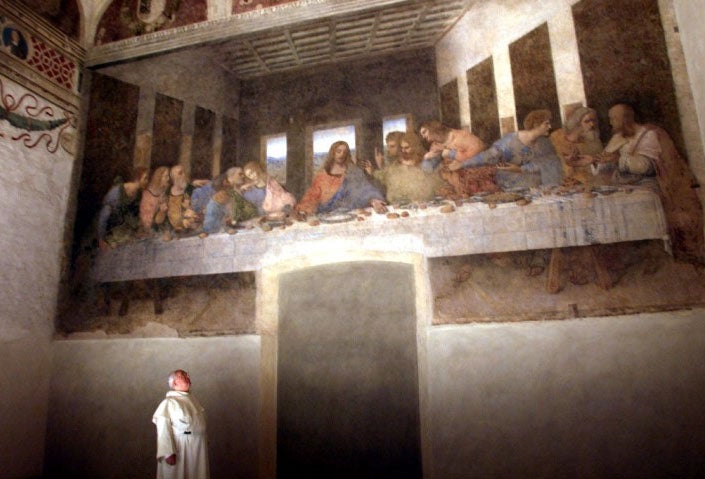Vatican looks to modern artists for divine inspiration
The Holy See is seeking fresh talent. Could Damien Hirst be the new Michelangelo?

Your support helps us to tell the story
From reproductive rights to climate change to Big Tech, The Independent is on the ground when the story is developing. Whether it's investigating the financials of Elon Musk's pro-Trump PAC or producing our latest documentary, 'The A Word', which shines a light on the American women fighting for reproductive rights, we know how important it is to parse out the facts from the messaging.
At such a critical moment in US history, we need reporters on the ground. Your donation allows us to keep sending journalists to speak to both sides of the story.
The Independent is trusted by Americans across the entire political spectrum. And unlike many other quality news outlets, we choose not to lock Americans out of our reporting and analysis with paywalls. We believe quality journalism should be available to everyone, paid for by those who can afford it.
Your support makes all the difference.Pope Benedict XVI has launched a campaign for a new era of religious art to rival the works of the Medicis. As religious themes become increasing influential among contemporary artists, the Holy See, which governs the Catholic Church, is searching for rich patrons to sponsor works in new houses of worship designed by cutting-edge architects.
In an attempt to "lead by example", the Pontifical Council for Culture is now setting up a committee to find "world-famous" contemporary artists it can commission to produce new religious and spiritual works.
These will be shown during next year's Venice Biennale, which the Vatican will attend for the first time and which it once dismissed as a "debacle" that demonstrated "the breakdown of art in modern times". One UK-based benefactor, who wants to remain anonymous, has already been found to sponsor this project.
"We are trying to get a dialogue up and running between the church and contemporary art – particularly artists at the highest level," said Monsignor Gianfranco Ravasi, the president of the Pontifical Council for Culture.
"We are looking for world-famous people. Venice is a showcase for all the big countries in the world and the Holy See would like to be there too. We're trying to get the best of international artists on our side who can create new works with a religious or spiritual subject."
Christianity has formed a cornerstone of Western art for 1,500 years, with themes such as the Adoration of the Magi or the Last Supper inspiring the likes of Botticelli and Leonardo da Vinci. Long gone, however, are the days when a Pope, such as Julius II who commissioned Michelangelo to paint the ceiling of the Sistine Chapel or Raphael to paint his portrait, could command the greatest artists of the day.
The rise of abstract and conceptual art has seen the once-dominant influence of the church decline as it continued to rely on figurative work. An attempt by Pope Paul VI in the 1960s to embrace contemporary art was stymied by traditionalists.
Now, however, the Holy See wants to "revive" its role in inspiring art, and inspiring others to pay for it. Mgr Ravasi suggested a presence at Venice would hopefully kick-start the Vatican's ongoing involvement in contemporary art. These works would enhance magnificent new churches designed by some of the world's most renowned architects, such as Renzo Piano's Padre Pio Pilgrimage Church in central Italy and Richard Meier's Jubilee Church in Rome.
"The [current] art works are not at the same level as the buildings," Mgr Ravasi said. "So we are trying to bring the art up to the same level as the architecture."
While no artists have yet been identified, Mgr Ravasi said the British sculptor Anish Kapoor was the type of artist they were looking for. The Turner Prize-winner Mark Wallinger may also be considered after his Via Dolorosa – an 18-minute film that silently replays the crucifixion scene from Franco Zeffirelli's 1977 TV drama Jesus of Nazareth – was temporarily displayed in Milan's cathedral in 2005.
Tim Marlow, exhibitions director at London's White Cube Gallery, which displays many of Britain's biggest artists, said that there has been a recent trend for church buildings to show temporary exhibitions. "I think it's a brave and important initiative by the church. Contemporary artists such as Damien Hirst, Chris Ofili and Sam Taylor-Wood do include religious iconography in their work but it is in a critical and questioning manner. I wonder whether the church can commission work that is both provocative and questioning."
The curator and writer Giles Waterfield added that there was scope for contemporary art in churches, pointing to Olafur Eliasson's The Weather Project, the giant sun which lit up the Tate Modern's Turbine Hall in 2003-04. He warned, however, that the emphasis should be quality of art rather than the fame of the artists.
There is still resistance in the church to modern art, however. Last year the German artist Gerhard Richter unveiled his new stained-glass window in Cologne Cathedral, a mosaic of 11,200 coloured squares in a pattern randomly generated by computer to suggest the work of the divine in seeming chaos. It was denounced by the city's Catholic Cardinal Joachim Meisner, who said "it belongs in a mosque, or another house of prayer, not this one".
Join our commenting forum
Join thought-provoking conversations, follow other Independent readers and see their replies
Comments